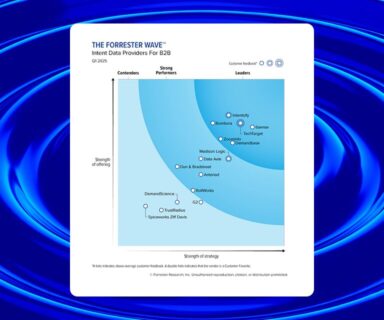 A customer recently asked my team to provide insights on the innovations we’re seeing in the areas of content marketing, demand generation and nurture in tech marketing. This was certainly a broad request, but our team was able to quickly hone this down to four specific, closely related areas of focus.
A customer recently asked my team to provide insights on the innovations we’re seeing in the areas of content marketing, demand generation and nurture in tech marketing. This was certainly a broad request, but our team was able to quickly hone this down to four specific, closely related areas of focus.
Before sharing the insights, let’s start with the source of the info (and why you should care what they think). You may not know this, but TechTarget has long been a primary provider premium lead generation services for technology companies. Although our services range far beyond this, we have extensive expertise in this critically important marketing function.
Our Content Marketing team is annually responsible for managing more than 5,000 lead gen campaigns, syndicating more than 12,000 content assets, and writing and analyzing response of more than 100,000 email promos.
All team members are all aligned to specific technologies. So for any individual tech market, they’re experts on what works in lead generation and content marketing, what doesn’t, what’s emerging, what’s over-covered and how competitive the market really is. They always know which vendors are in market, what types of assets are being syndicated, what topics are getting covered, and what is (and isn’t) getting response in promos.
With that context as a backdrop on the source, here are the trends they’re seeing across technology as we approach 2020:
#1 – Content Marketers are using intent data to improve nurture results
Two areas that many marketers feel could be improved:
- Effectiveness of nurture campaigns in building pipeline
- Effectiveness in using intent data to build pipeline
The good news is that we’re seeing savvy customers combine these challenges into a winning strategy.
How? Consider these two items:
- First, in traditional lead generation campaigns, if the targeted contact doesn’t act, you don’t capture their info. This is a very tactical reality. So your copy, offers and creative for lead generation are all built with response rate as the obviously critical metric. The job of every promo is to convert from that single interaction.
- Second, with intent data, because the contacts may not have taken that first action with you, you may not know quite what to do with them. This difference might mean that they may not fit neatly into you established engine of lead scoring and sales/marketing follow up.
So, our customers are focusing on nurture activities that incorporate intent data to build pipeline. It creates two opportunities for marketers. It jumpstarts the process of educating and engaging these active contacts and accounts. And it also enables a proving ground for nurture tactics – these contacts that have shown intent elsewhere are a great resource for testing and trying out new promo ideas.
#2 – Non-traditional offers work in nurture
In the past year, we’ve reviewed the copy and offers for hundreds of nurture campaigns as a service to our demand gen customers, and have noticed some distinct trends.
Most interesting is the use of creative offers that aren’t limited to “traditional” content offers. We see offers for product demos, meetings/appointments, webinars, podcasts and face-to-face events.
As a group that focuses on lead generation marketing, we’re accustomed to advising against this approach, as we have years and years of data showing that they simply don’t respond in lead gen as well as document-based reports. But the goal here is different. In nurture, you aren’t building promos and offers based solely on the goal of getting a one-time response, rather you’re educating prospects via a sustained campaign, as you own their contact info and you have data that already establishes their recent interest. So you’re not beholden to the simple KPI of response rate – you can trade response rate for arguably more meaningful engagements and alternative methods of education.
But think them though! The non-traditional offers that we see work go the extra mile in proving the value of the request. For example, a request for a meeting is explicit in the immediate value the prospect will get in exchange for his or her time.
#3 – Late stage content can work earlier in the buying cycle
As a general rule, later, decision-stage content doesn’t perform as well in lead gen as awareness- or consideration-stage content. We see this consistently play out in campaign metrics. The reason is straightforward: if you’re trying to drive a high quantity of leads, your chances are much better if your information is inclusive of the much larger pool of potential customers who likely are not at a point in their research where they’re interested in solution-level specifics.
That said, we would never discourage decision-stage content as part of your asset mix. Rather, we’d encourage late stage content that focuses on comparative data – showing how different solutions in a market stack up against one another. The response is consistently better than single-solution or single vendor content. We consistently advise this, and those who develop this content are seeing real results.
Along these lines, there are two things worth mentioning:
- First, many feel a natural reluctance to name competitors in their marketing piece. Why draw attention to them? But you need to realize that they are where you are — and they’re always a few clicks away for a potential buyer. So, take the opportunity to control the narrative yourself.
- Second, it’s generally a good investment to partner with well-known analyst groups or custom publishers for these comparative pieces. It can be more expensive than writing it yourself, but it brings more credibility to the effort and the ROI is real.
Ultimately, whether it’s analyst-authored or not, we’re seeing lead gen marketers have a lot of success in not just describing the problems their solutions address, but doing comparative pieces vs. competitors.
#4 – Aligning market maturity and content type
The customers who routinely see the most success are those who develop, and syndicate with us, content types that align buying stage mix with market maturity.
Example: Flash Storage is a mature technology that’s been in the market for more than a decade. But the places and ways to deploy it are evolving quickly. So we see “This is Flash 101” content responding poorly, as IT teams have been hearing about it for years and have long understood how it works. What we see working is content that addresses today’s specific applications of flash, updated to today’s hottest tech deployments.
Content portfolios that are market-maturity-aware perform better across the board than those that simply hammer away at late-stage content in an attempt to artificially condense buy cycles.
We hope this is helpful info. Check back in this blog space for more perspectives on what we’re seeing in content marketing.



